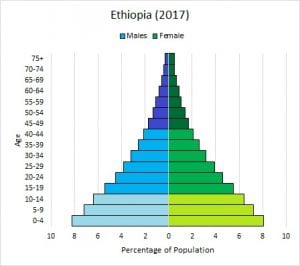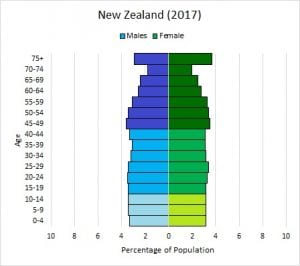
3.6 Age Structure Diagrams
2 min read•december 29, 2022
Karla Jauregui Sandoval
Karla Jauregui Sandoval
Age Structure Diagrams

Image Courtesy of Wikimeadia
An age structure diagram is a model that predicts the population growth rate by a shape. It shows a comparative ratio of males to females and the bars show various age groups from infants to adolescents to reproductive and post-reproductive stages. Certain age structure diagrams will have more representation at one end, while others will have more representation at the other end (or in the middle!).
Pre-reproductive age: 0-14
Reproductive age: 15-44
By using an age structure diagram, it can be predicted whether a population will increase, decrease or maintain stability. Predictions can also be made as to why this trend is showing: for example, is a population dying out because a majority of their individuals are above 45? The image below shows an age structure diagram for Ethiopia, and a classic example of a population in rapid growth. There are many more children in each generation than their parents, meaning that couples are having a lot of children. In this example the majority of the population is very young.

Image Courtesy of PopulationEducation
The diagram below shows New Zealand and an example of a population with stable numbers. This population has about the same amount of individuals in each age bracket. This suggests parents have access to reproductive education and can choose replacement level reproduction, or to have about two children per each couple.

Image Courtesy of PopulationEducation
In conclusion, age structure diagrams help us visualize at which point a society currently is in terms of average age and how they may react given a change in birth/death rate.
Key Terms to Review (5)
Age Structure Diagrams
: Age structure diagrams (also known as age pyramids) are graphical representations that show the distribution of different age groups within a population. They provide valuable information about birth rates, death rates, life expectancy, and overall demographic trends.Population Stability
: Population stability refers to a state where the size and composition of a population remain relatively constant over time, with birth rates balancing out death rates.Post-reproductive age
: Post-reproductive age refers to the stage in an organism's life when it is no longer capable of reproducing or producing offspring.Replacement Level Reproduction
: Replacement Level Reproduction refers to the number of children a couple needs to have in order to replace themselves in the population. It takes into account factors such as mortality rates and average life expectancy.Reproductive age
: Reproductive age refers to the period in an organism's life when it is capable of reproducing and producing offspring.3.6 Age Structure Diagrams
2 min read•december 29, 2022
Karla Jauregui Sandoval
Karla Jauregui Sandoval
Age Structure Diagrams

Image Courtesy of Wikimeadia
An age structure diagram is a model that predicts the population growth rate by a shape. It shows a comparative ratio of males to females and the bars show various age groups from infants to adolescents to reproductive and post-reproductive stages. Certain age structure diagrams will have more representation at one end, while others will have more representation at the other end (or in the middle!).
Pre-reproductive age: 0-14
Reproductive age: 15-44
By using an age structure diagram, it can be predicted whether a population will increase, decrease or maintain stability. Predictions can also be made as to why this trend is showing: for example, is a population dying out because a majority of their individuals are above 45? The image below shows an age structure diagram for Ethiopia, and a classic example of a population in rapid growth. There are many more children in each generation than their parents, meaning that couples are having a lot of children. In this example the majority of the population is very young.

Image Courtesy of PopulationEducation
The diagram below shows New Zealand and an example of a population with stable numbers. This population has about the same amount of individuals in each age bracket. This suggests parents have access to reproductive education and can choose replacement level reproduction, or to have about two children per each couple.

Image Courtesy of PopulationEducation
In conclusion, age structure diagrams help us visualize at which point a society currently is in terms of average age and how they may react given a change in birth/death rate.
Key Terms to Review (5)
Age Structure Diagrams
: Age structure diagrams (also known as age pyramids) are graphical representations that show the distribution of different age groups within a population. They provide valuable information about birth rates, death rates, life expectancy, and overall demographic trends.Population Stability
: Population stability refers to a state where the size and composition of a population remain relatively constant over time, with birth rates balancing out death rates.Post-reproductive age
: Post-reproductive age refers to the stage in an organism's life when it is no longer capable of reproducing or producing offspring.Replacement Level Reproduction
: Replacement Level Reproduction refers to the number of children a couple needs to have in order to replace themselves in the population. It takes into account factors such as mortality rates and average life expectancy.Reproductive age
: Reproductive age refers to the period in an organism's life when it is capable of reproducing and producing offspring.
Resources
© 2024 Fiveable Inc. All rights reserved.
AP® and SAT® are trademarks registered by the College Board, which is not affiliated with, and does not endorse this website.